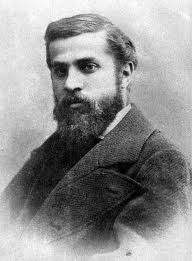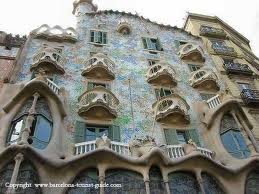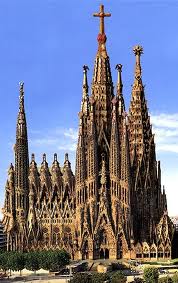Gaudi in Barcelona
Antoni Gaudí

When we think of Spanish architecture one of the first buildings that come to mind is the Sagrada Familia Basilica, the Güell Palace in Parc Güell or Casa Milà (also known as La Pedrera). Any Barcelona city guide will tell you that no visit to the Catalan city is complete without a tour of Gaudí's most important buildings.
Antoni Gaudí was born in Reus in 1852 and he is the top representative of the Catalan modernism. He had an unparalleled sense of geometry and volume and a great imaginative ability, so much, in fact, that he was able to mentally project most of his works without having to plot them, preferring to create 3D models. At other times he improvised, giving instructions along the way.
Antoni Gaudí also had another talent. Not only did he design the structure of a building, he also visualized and took care of the decorative aspects, so he created every little detail of his constructions, thus integrating architecture with several crafts that the architect himself mastered to perfection: ceramics, glassworks, forging, carpentry, etc. He also introduced new techniques such as trecandís (similar to mosaics created with shards of broken ceramic tiles
There's little architecture with such personal hallmarks. Should you ever decide to travel to Barcelona, we suggest you visit some of Antoni Gaudí's buildings yourself, so you can get an idea of just how special his architecture is. Not only are his constructions breathtakingly beautiful, but they are perfectly integrated with the environment, too. Towards the late part of his life, Gaudí drew much of his inspiration from nature, giving dynamic and organic forms to the buildings. His art perfectly combines his four passions: architecture, nature, religion and his love for Barcelona.
The streets of Barcelona themselves are a museum when it comes to Antoni Gaudí's architecture, however there are some buildings that are actual museums.
Gaudí's House Museum
Where: Parc Güell in Barcelona. Metro Station Lessep (L3) and follow the signs that lead to the park. Opening hours: October to March from 10 am to pm, April to September from 10 am to 8 pm. December 25 and 26 and January 6 from 10 am to 2 pm. Closed on January 1.
Opening hours: October to March from 10 am to pm, April to September from 10 am to 8 pm. December 25 and 26 and January 6 from 10 am to 2 pm. Closed on January 1.
Visit Gaudí's House Museum's website. It includes a virtual visit.
Located in Parc Güell, Gaudí's House Museum was the architect's residence from 1906 to 1925. The institution opened in 1963 and it hosts a private collection opened to the public that shows the most intimate aspects of Gaudí's life. Visitors can see how he lived as well as furniture and objects designed by the architect.
The permanent collection at Gaudí's House Museum helps to explore more in depth his projection and work methods and also to witness the system of crafts production in Catalonia during the modernist period.
Parc Güell is one of Gaudí's most important protects. When it was projected, it was destined to be a private urbanization, however, it is now a public space. At the end of the 19th century, a Catalan businessman, Eusebi Güell decided to create the urbanization and he commissioned Antoni Gaudí as the project's architect. The venture was located in a rural estate and the site works began in 1900. The urbanization was foreseen to have some 60 houses, equipped with several services for its inhabitants, including a caretaker, reception hall, a square, a market, a chapel and a surveillance service. Almost like a tiny functional town. Only two of the 60 houses were built, the works were stopped in 1914. A complete real-estate failure. Antoni Gaudí moved into the property in 1906.
But there is a lot more to see than just Gaudí's House Museum: Parc Güell itself is a wonderful outing with some of Gaudí's notable trecandís-style benches and famous lizard statues. You can't miss it!
Casa Milà | La Pedrera
Where: Passeig de Gràcia, 92, 08008 Barcelona (Metro Station Passeig de Gràcia or Diagonal) Opening hours: November to February from 9.30 am to 6 pm, March to October from 9 am to 8 pm. Closed on December 25, and from January 9 to 15.
Opening hours: November to February from 9.30 am to 6 pm, March to October from 9 am to 8 pm. Closed on December 25, and from January 9 to 15.
Visit La Pedrera's website
Casa Milà , popularly known as La Pedrera (which in Catalan means quarry) was designed by Antoni Gaudí and was constructed between 1906 and 1910. It's a modernist building commissioned by the couple Pere Milà i Camps y Roser Segimon i Artells. The building is impressively innovative, as the geometry uses straight lines to form curved shaped. All of the building's facade is constructed in limestone, except for the top part that is covered in white styles, a combination that evokes a snow peaked mountain.
Like with many other of Antoni Gaudí's works, Casa Milà 's inspiration was drawn from nature, and many experts have perceived shapes that remind them of cliffs or a river's torrent. The wrought iron balconies evoke climbing vines. Everything about the Casa Milà is worth seeing, including the rooftop, where there are stairs and chimneys covered with ceramic fragments that appear to be warrior's heads with helms.
La Pedrera is five stories high with two large interior courtyards and the mentioned rooftop. The building itself is the museum and it's also possible to visit a few of the apartments in order to see the interior decoration. The houses functions as a museum since 1986 when Caixa Catalunya purchased the property. Since then they have carried out several restoration and preservation works. The house was declared a national Historical Artistic monument in 1969, and in 1984 UNESCO declared it a World Heritage site. If you're ever in Barcelona to learn Spanish, we recommend you to include Casa Milà – La Pedrera – in your to-do list.
La Sagrada Familia
Where: Calle Mallorca, 401, 08013 Barcelona
Opening hours: October to March from 9 am to 6 pm, April to September from 9 am to 8 pm. December 25 and 26 and January 1 and 6 from 9 am to 2 pm.
Visit Sagrada Familia's website or purchase online tickets in advance
The construction of the Sagrada Familia began in 1882. In 1883 Gaudí took over the project and was in charge until his death in 1926. Since then, several architects have continued the temple's construction, following Antoni Gaudí's ideas. Some say with humor that the church will never be finished. The building itself has become an identity symbol of Barcelona and receives more than two million visitors per year.
The church's first style was neo-Gothic, but once Gaudí took the reins it was completely rethought. Like many other of his buildings, Gaudí pretty much improvised as he went along. One of the biggest innovations in his design were the high conical spires, getting narrower to the top, which give the impression that the Sagrada Familia is ascending. In ascending order they represent the 12 Apostles, the Virgin Mary, the Four Evangelists and Christ, obviously the tallest. As of 2010, only 8 of the 18 spires have been built.
The facades of the Sagrada Familia are all enhanced with their own carvings. The portals are individually designed, too. The interior of the Basilica is sublime, filled with revelatory details. Almost none of the surfaces are flat, the ornamentation mainly consists of abstract shapes and its many windows create a very special lighting. We suggest a visit to the interior of the Sagrada Familia as well as the outside.



